Kefir. Kombucha. Kvass. Fermented beverages can certainly be an acquired taste — and it’s especially true for beet kvass — but if you can learn to love these probiotic-rich potions, your body won’t be disappointed.
We love the following recipe for traditional beet kvass from wellness food blogger, Hannah Messinger of Nothing But Delicious, who told us all about the bev a few years back: Beet kvass is a probiotic tonic made from beets that was re-popularized by the landmark book on traditional foods, Nourishing Traditions. Kvass is a traditional Russian beverage made from fermenting scraps of wheat or rye bread with water, starter culture and a bit of salt. The flavor is unique, to say the least — almost like an earthy-sweet and salty veggie broth with just a hint of effervescence. To Hannah, “it tastes the way that soil smells in the springtime”. There are easy ways, however, to quickly turn it from something a little creepy-looking into something healthy that you’ll want to make a habit of.
We find that more and more people are gravitating towards traditional foods for their simplicity and nutritional soundness. If you’re tossing back bone broth and sprinkling sauerkraut on all the things, homemade beet kvass is a highly-functional and weirdly delicious natural addition. Especially during fall and winter, our bodies benefit from taking in more seasonal foods like root veggies — like beets! Below, we’re sharing Hanna’s do’s and don’ts for making homemade beet kvass, plus a simple recipe that’s waiting for it’s big debut in your daily beverage lineup…
How To Make Beet Kvass
Do:
…sanitize your beets and your jar, which should be a friendly, bad-bacteria-free environment in which the good bacteria in whey can thrive.
…fuss over cutting the beets. If the pieces are too large, the fermentation process will happen very slowly. If they’re too small, you might be making beet wine.
…seal your jar tightly. True lacto-fermentation happens in an anaerobic environment. One of the only ways that making kvass can go wrong is mold and mold can only grow where there is oxygen.
…drink kvass cold.
Don’t:
…worry if you come up short on whey. You actually don’t have to use whey at all, but it will expedite the fermentation process and add nutrition to your kvass.
…use plastic. For anything. Ever. It’s a hotbed for filth of all sorts.
…peel the beets- it’s difficult, messy and unnecessary. As long as you pull off any lingering roots and sanitize the whole beet with boiling water, you’re good to go.
…be alarmed if your toilet bowl turns red. This is a harmless phenomenon called beeturia and it happens to about 15% of people.
Homemade Beet Kvass
Ingredients:
32-ounce glass jar with lid
fine mesh strainer
coffee filter or cheesecloth
yogurt or kefir
10-12 ounces (one very large) beet
1 1/4 tsp kosher salt
2 Tbsp whey
filtered water
Directions:
Place a coffee filter or cheesecloth in a fine mesh strainer over a bowl and separate whey from yogurt or kefir- sometimes this takes a while, so give yourself time. Whey should be completely clear.
Pour boiling water over whole beets and into the jar to sanitize. Remove any roots and chop beets into 1/2″ cubes. Put them in the clean jar with whey and salt, then cover with filtered water.
Leave the jar on the counter for 48 hours. You can tell the kvass is ready when it’s really, really fizzy. At this point, you can let it sit for another day or two to develop a more sour flavor, or pop it in the fridge, where it keeps for about a week.
To Serve: Pour half a cup kvass into a tall glass, mix it with a splash of agave nectar, then top it with lots of ice and soda water. Use aromatic herbs, if you have some on hand. Muddle raw cane sugar with mint, thyme or basil before adding the kvass, or simply place a sprig in the glass so that it hits your nose before you begin to drink.












